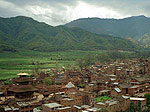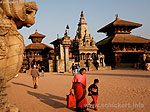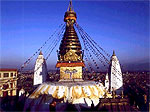|
|
|
| |
| Nepal - Historical, Heritage Sites & Beyond– 6 Nights and 7 Days. |
Tab 1
Historical, Heritage Sites and more – 6 Nights and 7 Days.
Kathmandu is home to some of the worlds best ancient and middle aged architecture. This 6 nights and 7 days tour packages covers not just the historic site, but also takes you through some small Newari towns. Here it may seem that the time has stopped for the people as you see them carry out their ancient way of life till date. You will also take a mountain flight along world’s highest mountain peaks.
For custom tailored tour packages please contact us.
 Panauti Village
Panauti Village |
 Bhaktapur
Bhaktapur |
 Swyambhunath
Swyambhunath |
Tab 2
| DAY |
ACTIVITIES |
| Day 1 |
Arrive at the Tribhuvan International Airport where you meet our representative who will assist you to the hotel. This day you will be left to explore the city on your own. |
| Day 2 |
After breakfast, you will be taken for a sightseeing of Swayambhunath stupa.
Swayambhunath - the “Monkey Temple”, the oldest shrine in the world established more than 2000 years ago lies at a distance of 3 KMS west of Kathmandu City. Situated on top of a high hill about 77 M above the level of Kathmandu Valley where legendary Manjushri discovered the lotus growing in the ancient Kathmandu Valley lake, Swayambhunath commands a superb view of the valley below. The four side of this ancient structure are painted with the all – seeing and compassionate eyes of Lord Buddha. Between the eyes is a mystical third eye symbolizing true wisdom. The nose, appearing as an incomplete question mark, is the Nepalese number of one, a symbol of unity.
Half day excursion to Dhulikhel and Panuti
Dhulikhel - A small quiet town, known for its traditional crafts, lies 30 km east of Kathmandu at an altitude of 1440 m. There are many vantage points in Dhulikhel which in a clear day offer a panorama of the eastern Himalayas. Looking out over low hills and valleys, the mountains rise up in an extended arc stretching from the far left to the far right. Climb a little to see the mountains from Cho Oyu in the east to Himalchuli in the west and more than 20 Himalayan Peaks including Annapurna (8091 M), Ganesh Himal (7429 M), Langtang (7234 M), Phurbi-Chyachu (6637 M), Gauri Shanker (7134 M), and Lhotse (8516 M) can be seen in all their glory. The great Himalayan Giants can be seen at their best early morning when the first rays of the sun hit the summits and their colours change which is very spectacular to watch.
Panauti - One of the finest of all-Newar settlements in the region is the village of Panauti. It is built at the confluence of two rivers, in a small valley surrounded by examples of early temple architecture. The Indreshwar Mahadev Temple reflects architecturally and historically one of the Newari cultures of the Kathmandu Valley. It is certainly a temple of fine proportions and exquisite carvings, simple yet beautiful. The roof struts, showing incarnations of Shiva are matchless in their serenity. Archaeological findings may reveal the existence of a pre-Licchavi settlement in or around Panauti. |
| Day 3 |
After breakfast you will be taken for a half day excursion to the traditional Newari village of Bungamati and Khokana
Bungamati lies five kilometers south of Patan. The approach road from Patan to Bungamati is dotted with small votive chaityas, appropriate for an ancient processionary path. The village of over 2,000 people is tightly clustered against a hilly riverside slope, surrounded by terraced rice fields and clumps of trees. Open ponds flank the paved path as it enters the village.
Past a Ganesh temple, a series of steps leads to a gate guarded by two lions and the head of a third one, which juts from a ramp obviously built around the animal. Here is the powerful, shikhara-style Rato Machhendranath temple, with heavy columns and beautiful supports in its lower part. Through the grille of the wooden door of the nearby Lokeshwar Shrine, you may catch a glimpse of the huge head of Bhairav, with crooked nose, greedy lips and global like eyes.
Ten minutes walk away, past the important Karya Binayak shrine on a tree-covered hillock, is the village of Khokana, slightly bigger than Bungamati with a population of about 3,000 Newari Buddhist. It is famous for its mustard-oil manufacturing. It is worthwhile to seek out one of the village's oil presses, located in poorly lit factories with medieval atmosphere.
Khokana's streets are brick and stone-paved with central gutters. The main street is remarkably wide. It was built after the 1934 earthquake. The village's main temple is dedicated to the goddess Shekali Mai, also known as Rudrayani, one of the Valley's nature goddesses.
In the evening, half day sightseeing of Patan city.
Patan City, the City of arts and architecture founded in 250 A.D. and also known as Lalitpur. It is renowned for its fine works in bronze, silver and copper. Visit the Durbar Square, Royal Baths, Mahaboudha, Krishna Mandir and Hiranya Varna Mahabihar (the Golden Temple). |
| Day 4 |
After breakfast you will be taken for a scenic mountain flight.
Mountain Flight - Transfer to airport for early morning Mountain Flight. This is an enchanting 50 minutes flight over the world's highest mountain range where you can enjoy close-up views of Mt. Everest and other Himalayan giants like Ama Dablam, Lhotse etc.
Then you will be taken for a half day sightseeing of the old city of Bhaktapur.
Bhaktapur, home of medieval art and architecture, also known as the 'City of Devotees' and for its majestic monuments, colourful festivals and the native Newars, best known for their long history of craftsmanship, the ancient city is also variously known as the “Living Heritage”. Bhaktapur is more like an open museum and the ambience here is such that it instantly transports visitors back into lost civilization the moment they step into Bhaktapur. Tread the 17th century along cobbled pavements and marvel at the ancient architectures. Bhaktapur has its gem in the Durbar Square - a World Heritage Site listed by UNESCO. Strewn with unique palaces, temples and monasteries best admired for their exquisite artworks in wood, metal and stone, the palatial enclave has bewitched pilgrims and travelers for centuries. Adding to the mesmerizing environs is the snow capped Himalayan range that makes the backdrop of the city. Visit the Lion Gate, Datttraya Temple, Peacock window, Nyatapola, Pottery, the Picture Gallery, the Golden Gate, and the Palace of Fifty five Windows.
After your return, you will be left on your own to explore the city. |
| Day 5 |
After breakfast this day, you will be taken for a full day excursion to Nagarkot. You will also be taken for a sightseeing of Changunarayan Temple and visit to the famouse Hindu and Bhuddhist Sacred monuments.
Nagarkot – Located 30 KMS east of Kathmandu on the valley rim is a favorite getaway for those who seek Himalayan scenery and rural serenity. Nagarkot is situated at an elevation of 2175 M and offers possibly the best display of the Himalaya in a clear day while remaining in the proximity of the valley. One can see 5 of the world’s 10 tallest peaks including Ganesh Himal (7429 M), Langtang (7234 M), Gan Chenpo (6397 M), Shishapangma (8013 M), Gur Karpori (6874 M), Dorje Lhakpa (6988 M), Lenpo Gang (7083 M), Phurbi Chyachu (6637 M), Makalu (8463 M), Cho Oyu (8201 M), Lhotse (8516 M), Manaslu (8163 M) etc and above all a glimpse of a dark shape in the back is visible in a very clear day and that is Sagarmatha (Everest – 8848 M).
Changu Narayan - The temple of Changu Narayan, built on a hilltop some 12 kilometers east of Kathmandu dates back to the 4th century. As you walk through the main entrance you are greeted by a couple of stone elephants, then encounter a twin roofed pagoda and the main two-tiered temple. In the center of the main temple is Vishnu, with 10 arms going through the different layers of the universe. This beautiful priceless piece of the 5th or 6th century is surrounded by half a dozen more images dating back to the 9th century. There is also an image of Garuda, the mythical bird that serves as Vishnus heavenly vehicle. Besides, it is one of the oldest and most important Licchavi inscriptions in the Valley.
Pashupatinath - This is the most sacred of all Hindu temples in Nepal situated on the banks of the holy Bagmati River. Non - Hindus are not allowed to enter the temple precincts but may look into premises from the opposite bank. It draws tens of thousands of pilgrims and devotees from Nepal and India during the festival of Mahashivaratri (the night of Lord Shiva).
Boudhanath - possibly the world's largest Buddhist stupa and a site of great veneration for Buddhists. Around the stupa have sprung up number of monasteries of the different sects of Tibetan Buddhism including one (on the west side of the stupa) that houses an enormous seated statue of Maitreya Buddha splendidly adorned. |
| Day 6 |
After breakfast you will be taken for a half day excursion to Daksinkali Temple, Pharping and Chovar Gorge.
Dakshinkali - Situated in a natural recess between two mountains, at the spot where two streams unite between forested hillsides, is a place of considerable beauty - Dakshinkali. It is decorated with brass tridents and a canopy adorned with snakes. Inside, the main Kali statue is of black stone. The six armed goddess, trampling a male human, stands in the company of Ganesh, seven Ashta Matrikas and a free shaped stone of Bhairav. Legends say that Kali herself commanded a 14th century Malla king to build her this shrine.
The most spectacular, regular, open religious worship is performed here. Twice a week, a large-scale animal massacre is staged; an even more incredible annual ritual is held during Dasain, with the image of Kali being bathed in blood. Fittingly, this is at a shrine to the Dakshin or 'southern' Kali.
Pharping: 18 KMS south of Kathmandu is the small fortress town of Pharping. The site draws both Hindus and the Buddhists with its sacred shrines to Vishnu, Vajra Yogini, Gorakhnath and Guru Rinpoche. The entire hill is full of shrines, temples and monasteries, exquisitely set into the natural setting.
Chobar - Legend tells us that the waters of the lake of Kathmandu escaped through the beautiful Gorge of Chobar after being released by Manjushri. This natural wonder, is located southwest of the city, where Chobar Hill, the highest point in a range of gentle hills, is sliced in two by the waters of the Bagmati River.
The famous Ganesh temple, known as Jal Binayak is located here. The most remarkable features of this triple roofed structure - built in the 15th century are the numerous water vessels, pots and pans nailed to boards all along the building. Facing the shrine, a stone shikhara is believed to be the entrance to a stone cave that cuts through the hill, emerging at the Chobar Cave. On one side is a deep scar in the Chobar Hill which legend says was cut by Manjushri's sword.
Evening you will be left at your own leisure.
|
| Day 7 |
After breakfast you will be left on your own until departure time. Then you will be taken to the airport for your final departure.
For custom tailored tour packages please contact us. |
Tab 3
|
|
 |
Kathmandu Culture Explore
- 3 Nights and 4 Days
This 3 Night/4 Days tour package covers all the major city in Kathmandu Valley like Kathmandu, Bhaktapur, Patan ...
Read more...
|
|
 |
Essence of Nepal
- 8 Nights and 9 Days
This 9 days trip will give you the true essence of Nepal. From UNESCO World Heritage sites to the natures perfect bliss...
Read more...
|
|
|
| |
 |
|
|
